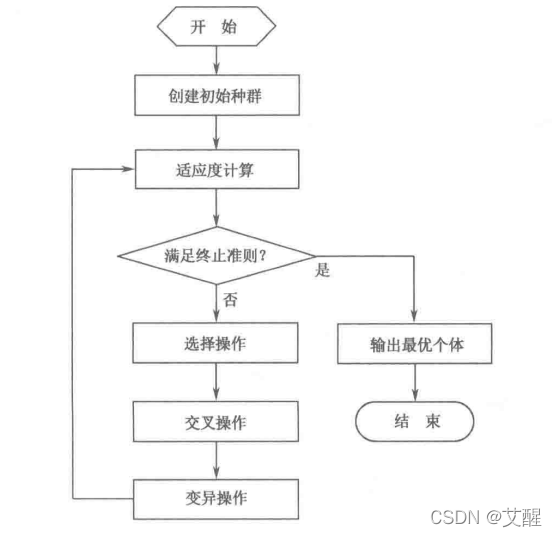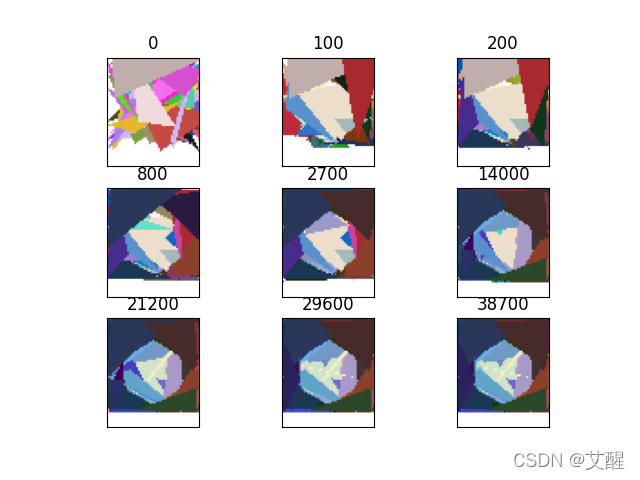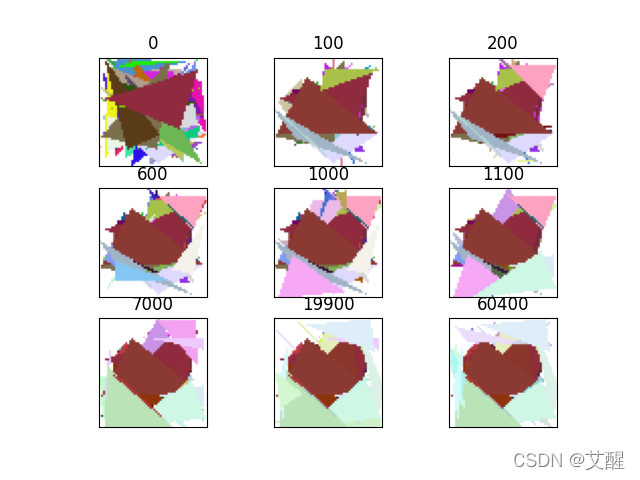python 图片拟合
艾醒 人气:0引言
算法思路
假设我们有这样一个生物族群,他们的每个基因片段都是一个个三角形(即只含三个点和颜色信息),他们每个个体表现出的性状就是若干个三角形叠加在一起。假设我们有一张图片可以作为这种生物族群最适应环境的性状,即长得越像这张图片的越能适应环境,越不像这张图片的越容易被淘汰。
当然作为一个正常的生物族群,他应该也会有正常的繁衍以产生新个体。产生新个体的过程中来自父亲和母亲的基因会进行交叉互换和变异,变异又可以有增加基因片段、减少基因片段以及不同位置的基因片段顺序互换。
但是一个族群不能够无限的繁殖,我们假设环境资源只能容纳有限的生物族群规模,所以我们在产生足够多的后代之后就要把他们放到族群里与族群内部进行竞争淘汰。这样一来,通过不断地淘汰,这个族群就会越来越像我们给定的图片。这就是算法的基本思路。
流程图

下面我们来看一下实现过程,为了方便解释,我们会结合python建立类似于伪代码的函数进行解释,不能直接运行,具体可运行的代码可直接下载参照最后的类封装的完整代码
预备知识及准备工作
打开图片
我们使用imageio中的imread打开图片,这里为了方便后续使用我们建立OpenImg函数,返回打开的图片img(格式为array),图片的格式(方便后期图片的保存),图片的大小:row和col(为后期画图做准备)。
from imageio import imread
def OpenImg(imgPath):
img = imread(imgPath)
row, col = img.shape[0], img.shape[1]
return img, imgPath.split(".")[-1], row, col
随机生成生物族群
我们假设一个族群的最大生物个数为max_group,用groups来表示族群,g为族群内的生物个体,运用随机数随机产生个体。
from random import choice
for i in range(max_group):
g = []
for j in range(features):
tmp = [[choice(np.linspace(0, row, features)), choice(np.linspace(0, col, features))] for x in range(3)]
tmp.append("#" + ''.join(choice('0123456789ABCDEF') for x in range(6)))
g.append(tmp.copy())
groups.append(g.copy())
按照生物性状画图
我们使用PIL画图,首先我们建立一个空白的画布,然后再将个体的特征(三角形)画到图上。
from PIL import Image, ImageDraw def to_image(g): array = np.ndarray((img.shape[0], img.shape[1], img.shape[2]), np.uint8) array[:, :, 0] = 255 array[:, :, 1] = 255 array[:, :, 2] = 255 newIm1 = Image.fromarray(array) draw = ImageDraw.Draw(newIm1) for d in g: draw.polygon((d[0][0], d[0][1], d[1][0], d[1][1], d[2][0], d[2][1]), d[3]) return newIm1
对比生物个体和目标图片的相似度
使用structural_similarity对比两个图片的相似度,此时两个图片都应该是array类型
from skimage.metrics import structural_similarity
def getSimilar(g) -> float:
newIm1 = to_image(g)
ssim = structural_similarity(np.array(img), np.array(newIm1), multichannel=True)
return ssim
保存图片
调用我们之前建立好的to_image函数先将个体转换成图片,然后将图片保存即可。
def draw_image(g, cur, imgtype):
image1 = to_image(g)
image1.save(os.path.join(str(cur) + "." + imgtype))
算法主体
交叉互换
考虑到后期的基因片段的增添和减少,所以应该分为两步,其一是相重合的位置进行交叉互换,以及对于多出来的尾部进行交叉互换,我们按照随机率random_rate和重合位置长度min_locate来确定交换的位数。然后我们使用sample选出若干位置进行互换。交换结束后再对尾部进行互换
random_rate = random() def exchange(father, mother)->[]: # 交换 # 随机生成互换个数 min_locate = min(len(father), len(mother)) n = randint(0, int(random_rate * min_locate)) # 随机选出多个位置 selected = sample(range(0, min_locate), n) # 交换内部 for s in selected: father[s], mother[s] = mother[s], father[s] # 交换尾部 locat = randint(0, min_locate) fhead = father[:locat].copy() mhead = mother[:locat].copy() ftail = father[locat:].copy() mtail = mother[locat:].copy() # print(fhead, ftail, mhead, mtail) fhead.extend(mtail) father = fhead mhead.extend(ftail) mother = mhead return [father, mother]
基因突变
随机选择的原理和目的与上面类似,这里我们把重新生成某个基因片段的信息看作基因突变。
random_rate = random()
def mutation(gen):
# 突变
# 随机生成变异个数
n = int(randint(1, 100) / 1000 * len(gen))
selected = sample(range(0, len(gen)), n)
for s in selected:
tmp = [[choice(np.linspace(0, row, 100)), choice(np.linspace(0, col, 100))] for x in range(3)]
tmp.append("#" + ''.join(choice('0123456789ABCDEF') for x in range(6)))
gen[s] = tmp
return gen
基因片段易位
在个体的基因组内随机选择基因片段进行位置互换。
def move(gen): # 易位 exchage = int(randint(1, 100) / 1000 * len(gen)) for e in range(exchage): sec1 = randint(0, len(gen) - 1) sec2 = randint(0, len(gen) - 1) gen[sec1], gen[sec2] = gen[sec2], gen[sec1] return gen
增加基因片段
直接在个体基因组后面添加随机产生的基因片段即可。
features = 100
def add(gen):
# 增加
n = int(randint(1, 100) / 1000 * len(gen))
for s in range(n):
tmp = [[choice(np.linspace(0, row,features)),choice(np.linspace(0, col, features))] for x in range(3)]
tmp.append("#" + ''.join(choice('0123456789ABCDEF') for x in range(6)))
gen.append(tmp)
return gen
减少基因片段
随机减少个体的若干基因片段
def cut(self, gen):
# 减少
n = int(randint(1, 100) / 1000 * len(gen))
selected = sample(range(0, len(gen)), n)
g = []
for gp in range(len(gen)):
if gp not in selected:
g.append(gen[gp])
return g
变异
以此调用以上的突变、易位、增添和减少产生4种状态的基因片段
def variation(gen): # 变异 gen = mutation(gen.copy()) gen1 = move(gen.copy()) gen2 = add(gen1.copy()) gen3 = cut(gen2.copy()) return [gen, gen1, gen2, gen3]
繁殖
繁殖过程包括交叉互换和变异,直接调用之前构造的函数即可
def breeds(father, mother): new1, new2 = exchange(father.copy(), mother.copy()) # 变异 new3, new4, new5, new6 = variation(father.copy()) new7, new8, new9, new10 = variation(mother.copy()) return [new1, new2, new3, new4, new5, new6, new7, new8, new9, new10]
淘汰
建立个体和其与目标的相似度相关的映射关系,并按照相似度排序,然后去除相似度较低的个体,直到剩余生物个体的数量为max_group为止。在这个函数中我们还返回了一个最优个体的相似度来方便监测。
def eliminated(groups):
group_dict = dict()
for gp in range(len(groups)):
group_dict[gp] = getSimilar(groups[gp])
group_dict = {key: value for key, value in sorted(group_dict.items(), key=lambda item: item[1], reverse=True)}
g = []
for key in list(group_dict.keys())[:max_group]:
g.append(groups[key].copy())
groups = g.copy()
return groups, list(group_dict.values())[0]
拟合
拟合过程先要进行若干次的繁殖,为了保证每次繁殖的个体数我们规定其至少选择最大个体数的一半数量的次数进行繁殖,繁殖之后的个体加入到种群当作和之前种群中的个体一起进行淘汰。通过这个过程我们每次淘汰都会将与目标差距最大的个体淘汰。
def breeds(father, mother): new1, new2 = exchange(father.copy(), mother.copy()) # 变异 new3, new4, new5, new6 = variation(father.copy()) new7, new8, new9, new10 = variation(mother.copy()) return [new1, new2, new3, new4, new5, new6, new7, new8, new9, new10]
示例展示
拟合时建议选择分辨率低的图片,如果选择的图片分辨率较高,可以使用以下代码降低图片分辨率
降低图片分辨率
from imageio import imread
from PIL import Image
imgPath = input("输入图片路径")
img = imread(imgPath)
img = img[::2, ::2, :]
img = Image.fromarray(img)
img.save(imgPath)
原图
我们以拟合一个小蓝鸟和一个心形为例来展示拟合过程


拟合过程展示
代码实现(这里已经事先将重复图片删除了)
import os
import math
import matplotlib.pyplot as plt
import matplotlib.image as image
path = "./xl"
length = len(os.listdir(path))
row = col = math.ceil(math.sqrt(length))
x = 1
lst = []
for d in os.listdir(path):
lst.append(int(d.split('.')[0]))
lst = sorted(lst)
for l in lst:
img = image.imread(os.path.join(path, str(l)+'.png'))
plt.xticks([])
plt.yticks([])
plt.subplot(row, col, x)
plt.imshow(img)
plt.xticks([])
plt.yticks([])
plt.title(str(l))
x += 1
plt.savefig(path)
plt.show()
效果


完整代码下载(已封装成类)
GitHub下载地址(推荐):
https://github.com/AiXing-w/Python-Intelligent-Optimization-Algorithms
加载全部内容